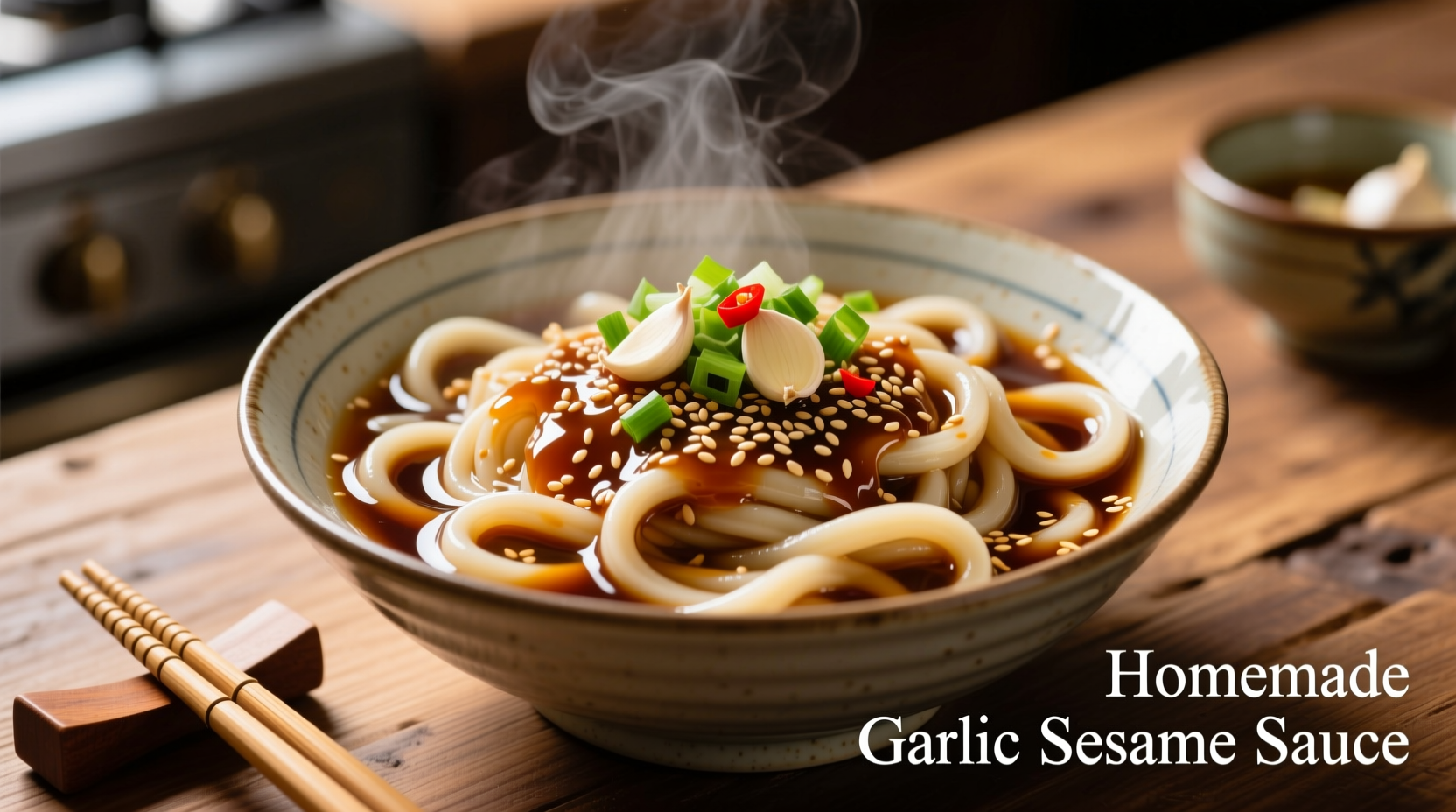What Makes Garlic Sesame Sauce Different From Similar Condiments
Many home cooks confuse garlic sesame sauce with tahini or hoisin, but key distinctions exist. Unlike tahini (made from raw sesame paste), authentic garlic sesame sauce uses toasted sesame ingredients for deeper flavor. Compared to hoisin's thick, sweet profile, garlic sesame sauce maintains a lighter consistency with pronounced garlic notes.
| Sauce Type | Base Ingredient | Garlic Content | Best Culinary Applications |
|---|---|---|---|
| Garlic Sesame Sauce | Toasted sesame oil/seeds | High (freshly minced) | Stir-fries, noodle dishes, salad dressings |
| Tahini | Raw sesame paste | None (typically) | Middle Eastern dips, hummus, Mediterranean dressings |
| Hoisin Sauce | Soybean paste, sugar | Low (added as flavoring) | Marinades, Peking duck, barbecue glazes |
Historical Evolution of Sesame-Based Sauces
Sesame's culinary journey spans millennia. Historical records from China's Han Dynasty (206 BCE–220 CE) document early sesame oil extraction techniques. The National Institutes of Health confirms sesame was among the first oilseed crops cultivated in Asia. By the Tang Dynasty (618–907 CE), cooks began combining sesame oil with garlic and soy—creating the foundation for modern garlic sesame sauce.
During the Silk Road trade era, Persian and Arab merchants introduced sesame to Mediterranean regions, while Chinese immigrants brought refined sesame preparation methods to Southeast Asia. The sauce evolved regionally: Japanese versions incorporate rice vinegar, Korean iterations add gochujang, and American-Chinese restaurants developed sweeter adaptations for Western palates.
Practical Applications: Where Garlic Sesame Sauce Shines
Understanding context boundaries prevents culinary missteps. This sauce excels in specific applications while failing in others:
- Perfect pairings: Noodle dishes (lo mein, ramen), vegetable stir-fries, grilled proteins, and as a dipping sauce for dumplings
- Limited effectiveness: Creamy pasta dishes, delicate seafood preparations, or desserts
- Complete mismatches: Tomato-based sauces, strongly acidic dressings, or dishes requiring neutral-flavored oils
Chef Liu Wei notes: "The sauce's toasted sesame foundation provides umami depth that complements high-heat cooking methods. When added during the final minute of stir-frying, it preserves garlic's aromatic compounds while preventing bitterness from overheated sesame oil."
Authentic Homemade Garlic Sesame Sauce Recipe
Commercial versions often contain unnecessary additives. This 10-minute recipe yields superior results using pantry staples:
Ingredients
- ¼ cup toasted sesame oil (not regular sesame oil)
- 3 large garlic cloves, finely minced
- 2 tablespoons soy sauce (use tamari for gluten-free)
- 1 tablespoon rice vinegar
- 1 teaspoon honey or maple syrup
- ½ teaspoon toasted sesame seeds (for texture)
- ¼ teaspoon chili flakes (optional)
Step-by-Step Preparation
- Gently warm sesame oil in small saucepan over low heat (do not smoke)
- Add minced garlic and sauté 60-90 seconds until fragrant but not browned
- Remove from heat and immediately add soy sauce, vinegar, and sweetener
- Stir in sesame seeds and chili flakes (if using)
- Cool to room temperature before storing

Storage Guidelines and Shelf Life
Proper storage maintains flavor integrity. The FDA Food Code recommends refrigerating homemade sauces containing fresh garlic within 2 hours of preparation. Store in airtight container:
- Refrigerated: Up to 2 weeks (separate oil layer is normal—shake before use)
- Room temperature: Maximum 2 days (risk of botulism with garlic-infused oils)
- Freezing: Up to 3 months in ice cube trays for portioned use
Troubleshooting Common Issues
Address these frequent preparation challenges with evidence-based solutions:
- Bitter taste: Caused by overheated sesame oil or browned garlic. Solution: Use low heat and remove garlic before color changes
- Separation: Natural with oil-based sauces. Solution: Shake vigorously or blend with 1 tsp cornstarch slurry
- Weak garlic flavor: Raw garlic loses potency when cooked too long. Solution: Reserve 1 clove minced raw and stir in after cooking
- Overly thick consistency: Too much sesame paste. Solution: Thin with warm water or additional rice vinegar
Professional Usage Tips
For restaurant-quality results at home:
- Toast sesame seeds yourself for maximum flavor (350°F for 3-5 minutes)
- Use fresh garlic—pre-minced versions lack aromatic complexity
- Add sauce during the "wok hei" phase (final 30 seconds of stir-frying)
- Dilute with broth for salad dressings to prevent overpowering greens
- Double the recipe and freeze portions for quick meal enhancement











 浙公网安备
33010002000092号
浙公网安备
33010002000092号 浙B2-20120091-4
浙B2-20120091-4